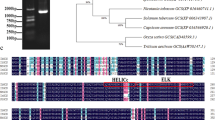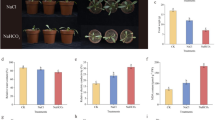Abstract
Ascorbic acid (AsA) plays an important role in scavenging reactive oxygen species (ROS) and reducing photoinhibition in plants, especially under stress. The function of SlGGP which encodes the key enzyme GDP-L-galactose phosphorylase in AsA synthetic pathway is relatively clear. However, there is another gene SlGGP-LIKE that encodes this enzyme in tomato, and there are few studies on it, especially under salt stress. In this study, we explored the function of this gene in tomato salt stress response using transgenic lines overexpressing SlGGP-LIKE (OE). Under normal conditions, overexpressing SlGGP-LIKE can increase the content of reduced AsA and the ratio of AsA/ DHA (dehydroascorbic acid), as well as the level of xanthophyll cycle. Under salt stress, compared with the wild-type plants (WT), the OE lines can maintain higher levels of reduced AsA. In addition, OE lines also have higher levels of reduced GSH (glutathione) and total GSH, higher ratios of AsA/DHA and GSH/oxidative GSH (GSSR), and higher level of xanthophyll cycle. Therefore, the OE lines are more tolerant to salt stress, with higher photosynthetic activity, higher antioxidative enzyme activities, higher content of D1 protein, lower production rate of ROS, and lighter membrane damage. These results indicate that overexpressing SlGGP-LIKE can enhance tomato resistance to salt stress through promoting the synthesis of AsA.










Similar content being viewed by others
Abbreviations
- A:
-
Antheraxanthin
- APX:
-
Ascorbic acid peroxidase
- CAT:
-
Catalase
- DHA:
-
Dehydroascorbic acid
- Fv/Fm:
-
The maximal photochemical efficiency of PSII
- GDP:
-
Guanosine 5′-diphosphate
- GGP:
-
GDP-L-galactose phosphorylase
- GR:
-
Glutathione reductase
- GSH:
-
Glutathione
- GSSH:
-
Oxidized glutathione
- MDA:
-
Malondialdehyde
- NADPH:
-
Nicotinamide adenine dinucleotide phosphate
- O2 •− :
-
Superoxide anion radical
- OE:
-
Overexpression
- Pn:
-
Net photosynthetic rate
- POD:
-
Peroxidase
- PSII:
-
Photosystem II
- REC:
-
Relative electric conductivity
- ROS:
-
Reactive oxygen species
- SOD:
-
Superoxidase dismutas
- V:
-
Violaxanthin
- VDE:
-
Violaxanthin de-epoxidase
- WT:
-
Wild-type
- Z:
-
Zeaxanthin
- ZEP:
-
Zeaxanthin epoxidase
References
Ahanger MA, Aziz U, Alsahli AA, Alyemeni MN, Ahmad P (2019) Influence of exogenous salicylic acid and nitric oxide on growth, photosynthesis, and ascorbate-glutathione cycle in salt stressed Vigna angularis. Biomolecules 10(1):42. https://doi.org/10.3390/biom10010042
Ahammed GJ, Li Y, Li X, Han WY, Chen S (2018) Epigallocatechin-3-gallate alleviates salinity-retarded seed germination and oxidative stress in tomato. J Plant Growth Regul 37(4):1349–1356. https://doi.org/10.1007/s00344-018-9849-0
Ahmad P, Jaleel CA, Salem MA, Nabi G, Sharma S (2010) Roles of enzymatic and nonenzymatic antioxidants in plants during abiotic stress. Crit. Rev. Biotechnol. 30(3):161–175. https://doi.org/10.3109/07388550903524243
Ahmad P, Tripathi DK, Deshmukh R, Singh VP, Corpas FJ (2019) Revisiting the role of ROS and RNS in plants under changing environment. Environ. Exp. Bot. 161:1–3. https://doi.org/10.1016/j.envexpbot.2019.02.017
Akladious SA, Mohamed HI (2018) Ameliorative effects of calcium nitrate and humic acid on the growth, yield component and biochemical attribute of pepper (Capsicum annuum) plants grown under salt stress. Sci. Hortic. 236:244–250. https://doi.org/10.1016/j.scienta.2018.03.047
Bahcesular B, Yildirim ED, Karaçocuk M et al (2020) Seed priming with melatonin effects on growth, essential oil compounds and antioxidant activity of basil (Ocimumbasilicum L) under salinity stress. Ind. Crops Prod. 146:112165. https://doi.org/10.1016/j.indcrop.2020.112165
Barth C, De Tullio M, Conklin PL (2006) The role of ascorbic acid in the control of flowering time and the onset of senescence. J. Exp. Bot. 57:1657–1665. https://doi.org/10.1093/jxb/erj198
Basyuni M, Wasilah M, Hasibuan PAZ et al. (2019) Salinity and subsequent freshwater influences on the growth, biomass, and polyisoprenoids distribution of Rhizophora apiculata seedlings. Biodiversitas, 20:288–295. https://doi.org/10.13057/biodiv/d200146
Decros G, Baldet P, Beauvoit B, Stevens R, Flandin A, P´etriacq P, et al. (2019) Get the balance right: ROS homeostasis and redox signalling in fruit. Front. Plant Sci.https://doi.org/10.3389/fpls.2019.01091
Duan M, Feng HL, Wang LY, Li D, Meng QW (2012) Overexpression of thylakoidal ascorbate peroxidase shows enhanced resistance to chilling stress in tomato. J. Plant Physiol. 169(9):867–877. https://doi.org/10.1016/j.jplph.2012.02.012
Duan M, Ma NN, Li D, Deng YS, Kong FY, Lv W, Meng QW (2012) Antisense-mediated suppression of tomato thylakoidal ascorbate peroxidase influences anti-oxidant network during chilling stress. Plant Physiol. Biochem. 58:37–45. https://doi.org/10.1016/j.plaphy.2012.06.007
Fotopoulos V, Kanellis AK (2013) Altered apoplastic ascorbate redox state in tobacco plants via ascorbate oxidase overexpression results in delayed dark-induced senescence in detached leaves. Plant Physiol. Biochem. 73:154–160. https://doi.org/10.1016/j.plaphy.2013.09.002
Foyer CH, Kyndt T, Hancock RD (2020) Vitamin C in plants: novel concepts, new perspectives, and outstanding issues. Antioxid. Redox Signal. 32:463–485. https://doi.org/10.1089/ars.2019.7819
Hasanuzzaman M, Bhuyan MHMB, Anee TI, Parvin K, Nahar K, Mahmud JA, Fujita M (2019) Regulation of ascorbate-glutathione pathway in mitigating oxidative damage in plants under abiotic stress. Antioxidants 8(9):384. https://doi.org/10.3390/antiox8090384
Hussain S, Khaliq A, Tanveer M, Matloob A, Hussain HA (2018) Aspirin priming circumvents the salinity-induced effects on wheat emergence and seedling growth by regulating starch metabolism and antioxidant enzyme activities. Acta Physiol. Plant. 40(4):1–12. https://doi.org/10.1007/s11738-018-2644-5
Khan I, Raza MA, Awan SA, Shah GA, Rizwan M, Ali B, … Huang L (2020) Amelioration of salt induced toxicity in pearl millet by seed priming with silver nanoparticles (AgNPs): The oxidative damage, antioxidant enzymes and ions uptake are major determinants of salt tolerant capacity. Plant Physiol. Biochem. 156:221–232. https://doi.org/10.1016/j.plaphy.2020.09.018
Khaliq A, Zia‐ul‐Haq M, Ali F, Aslam F, Matloob A, Navab A, Hussain S (2015) Salinity tolerance in wheat cultivars is related to enhanced activities of enzymatic antioxidants and reduced lipid peroxidation. CLEAN–soil, air, water, 43(8):1248–1258. https://doi.org/10.1002/clen.201400854
Kohli SK, Khanna K, Bhardwaj R, Abd Allah EF, Ahmad P, Corpas FJ (2019) Assessment of subcellular ROS and NO metabolism in higher plants: multifunctional signaling molecules. Antioxidants. 8(12):641. https://doi.org/10.3390/antiox8120641
Linster CL, Adler LN, Webb K, Christensen KC, Brenner C, Clarke SG (2008) A second GDP-L-galactose phosphorylase in Arabidopsis en route to vitamin C: covalent intermediate and substrate requirements for the conserved reaction. J. Biol. Chem. 283(27):18483–18492. https://doi.org/10.1074/jbc.M802594200
Linster CL, Gomez TA, Christensen KC, Adler LN, Young BD, Brenner C, Clarke SG (2007) Arabidopsis VTC2 encodes a GDP-L-galactose phosphorylase, the last unknown enzyme in the Smirnoff-Wheeler pathway to ascorbic acid in plants. J. Biol. Chem. 282:18879–18885. https://doi.org/10.1074/jbc.M702094200
Liu J, Li F, Liang L, Jiang Y, Chen J (2019) Fibroin delays chilling injury of postharvest banana fruit via enhanced antioxidant capability during cold storage. Metabolites 9(7):152. https://doi.org/10.3390/metabo9070152
Lorence A, Chevone BI, Mendes P, Nessler CL (2004) myo-Inositol oxygenase offers a possible entry point into plant ascorbate bio- synthesis. Plant Physiol. 134:1200–1205. https://doi.org/10.1104/pp.103.033936
Lu T, Lu, J.Z., Qi MF et al. (2021) Protective roles of D1 protein turnover and the xanthophyll cycle in tomato (Solanum lycopersicum) under sub-high temperature and high light stress. Front Agr Sci Eng 8(2):262–279. https://doi.org/10.15302/J-FASE-2021383
Mansoor S, Wani OA, Lone JK, Manhas S, Kour N, Alam P, Ahmad A, Ahmad P (2022) Reactive oxygen species in plants: from source to sink. Antioxidants 11:225. https://doi.org/10.3390/antiox11020225
Meng X, Wang JR, Wang GD, Liang XQ, Li XD, Meng QW (2015) An R2R3-MYB gene, LeAN2, positively regulated the thermo-tolerance in transgenic tomato. J Plant Physiol 175:1–8. https://doi.org/10.1016/j.jplph.2014.09.018
Müller-Moulé P, Havaux M, Niyogi KK (2003) Zeaxanthin deficiency enhances the high light sensitivity of an ascorbate-deficient mutant of Arabidopsis. Plant Physiol 133(2):748–760. https://doi.org/10.1104/pp.103.026252
Parvin K, Nahar K, Hasanuzzaman M et al (2020) Exogenous vanillic acid enhances salt tolerance of tomato: insight into plant antioxidant defense and glyoxalase systems. Plant Physiol. Biochem. 150:109–120. https://doi.org/10.1016/j.plaphy.2020.02.030
Paul D, Céline B, Guillaume D, Yoshihiro O, Jean-Philippe M, Joana J et al (2021) Overproduction of ascorbic acid impairs pollen fertility in tomato. J. Exp. Bot. 72(8):3091–3107. https://doi.org/10.1093/jxb/erab040
Sirikhachornkit A, Niyogi KK (2010) Antioxidants and photo-oxidative stress responses in plants and algae. Chloroplast Springer, Netherlands 31:379–396. https://doi.org/10.1007/978-90-481-8531-3_24
Smirnoff N (1996) The function and metabolism of ascorbic acid in plants. Ann Botany 780:661–669
Tóth SZ, Schansker G, Garab G (2013) The physiological roles and metabolism of ascorbate in chloroplasts. Physiol Plant. 148(2):161–75. https://doi.org/10.1111/ppl.12006
Wang LY, Li D, Deng YS, Lv W, Meng QW (2013) Antisense-mediated depletion of tomato GDP-L-galactose phosphorylase increases susceptibility to chilling stress. J Plant Physiol 170:303–314. https://doi.org/10.1016/j.jplph.2012.10.015
Wang LY, Meng X, Yang DY, Wang GD, Meng QW (2014) Overexpression of tomato GDP-L-galactose phosphorylase gene in tobacco improves tolerance to chilling stress. Plant Cell Rep. 33(9):1441–1451. https://doi.org/10.1007/s00299-014-1627-2
Wheeler GL, Jones MA, Smirnoff N (1998) The biosynthetic pathway of vitamin C in higher plants. Nature 393:365–369. https://doi.org/10.1038/30728
Wolucka BA, Goossens A, Inzé D (2005) Methyl jasmonate stimulates the de novo biosynthesis of vitamin C in plant cell suspensions. J Exp Bot 56(419):2527–2538. https://doi.org/10.1093/jxb/eri246
Wolucka BA, Van Montagu M (2003) GDP-mannose 3’,5’-epimerase forms GDP-L-gulose, a putative intermediate for the de Novo biosynthesis of vitamin C in plants. J Biol Chem 278:47483–47490. https://doi.org/10.1074/jbc.M309135200
Yang DY, Li M, Ma NN, Yang XH, Meng QW (2017) Tomato SlGGP-LIKE gene participates in chilling stress and pathogenic infection. Plant Physiol Biochem 112:218–226. https://doi.org/10.1016/j.plaphy.2017.01.006
Yang DY, Ma NN, Zhuang KY, Zhu SB, Liu ZM, Yang XH (2017) Overexpression of tomato SlGGP-LIKE gene improves tobacco tolerance to methyl viologen-mediated oxidative stress. J Plant Physiol 209:31–41. https://doi.org/10.1016/j.jplph.2016.10.013
Yang H, Dai L, Wei Y et al (2020) Melatonin enhances salt stress tolerance in rubber tree (Heveabrasiliensis) seedlings. Ind Crops Prod. 145:111990. https://doi.org/10.1016/j.indcrop.2019.111990
Ye L, Zhao X, Bao E et al (2019) Effects of arbuscular mycorrhizal fungi on watermelon growth, elemental uptake, antioxidant, and photosystem ii activities and stress-response gene expressions under salinity-alkalinity stresses. Front. Plant Sci. 10:863. https://doi.org/10.3389/fpls.2019.00863
Yi Z, Li S, Liang Y, Zhao H, Hou L, Yu S, Ahammed GJ (2018) Effects of exogenous spermidine and elevated CO2 on physiological and biochemical changes in tomato plants under iso-osmotic salt stress. J. Plant Growth Regul. 37(4):1222–1234. https://doi.org/10.1007/s00344-018-9856-1
Zhang QY, Wang LY, Kong FY, Deng YS, Li B, Meng QW (2012) Constitutive accumulation of zeaxanthin in tomato alleviates salt stress-induced photoinhibition and photooxidation. Physiol. Plantarum 146(3):363–373. https://doi.org/10.1111/j.1399-3054.2012.01645.x
Zhang YY, Li HX, Shu WB, Zhang CJ, Zhang W, Ye ZB (2010) Suppressed expression of ascorbate oxidase gene promotes ascorbic acid accumulation in tomato fruit. Plant Mol. Biol. Rep. 29(3):638–645. https://doi.org/10.1007/s11105-010-0271-4
Funding
This work was supported by the Natural Science Foundation of Shandong Province (ZR2019BC069), Major Project of Science and Technology of Shandong Province (2022CXGC010605), Modern Agricultural Technology System of Shandong Province (SDAIT-06–14), and Scientific Research Guidance Fund of Shandong Academy of Grape (SDAG2021B01).
Author information
Authors and Affiliations
Corresponding author
Ethics declarations
Conflict of interest
The authors declare no competing interests.
Additional information
Handling Editor: Néstor Carrillo
Publisher's Note
Springer Nature remains neutral with regard to jurisdictional claims in published maps and institutional affiliations.
Supplementary Information
Below is the link to the electronic supplementary material.
Rights and permissions
Springer Nature or its licensor holds exclusive rights to this article under a publishing agreement with the author(s) or other rightsholder(s); author self-archiving of the accepted manuscript version of this article is solely governed by the terms of such publishing agreement and applicable law.
About this article
Cite this article
Yang, DY., Zhuang, KY. & Ma, NN. Overexpression of SlGGP-LIKE gene enhanced the resistance of tomato to salt stress. Protoplasma 260, 625–635 (2023). https://doi.org/10.1007/s00709-022-01800-y
Received:
Accepted:
Published:
Issue Date:
DOI: https://doi.org/10.1007/s00709-022-01800-y




